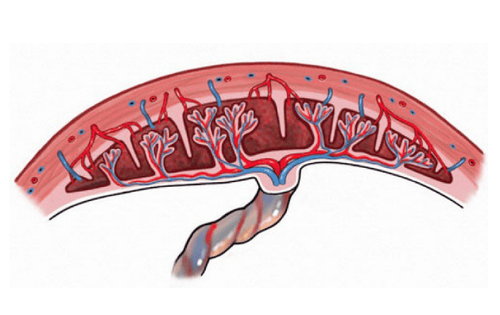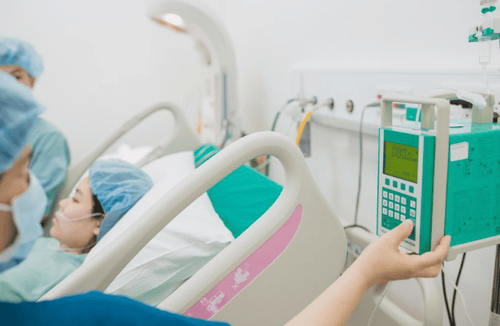This is an automatically translated article.
The article was professionally consulted by an Anesthesiologist, anesthesiologist, anesthesiologist - Department of General Surgery & Anesthesia - Vinmec Hai Phong International General Hospital.Endotracheal anesthesia is applied in cesarean section for pregnant women with placenta accreta to control the patient's breathing during and after surgery.
1. Overview of endotracheal anesthesia for cesarean section for pregnant women with placenta accreta
In cesarean section for pregnant women with placenta accreta, general anesthesia with endotracheal intubation, also known as endotracheal anesthesia, is used to control the patient's breathing during pregnancy. and after surgery. Or the mother's breathing cannot be controlled with a mask and must be maintained with inhalation anesthetics.2. What preparation should be done when endotracheal anesthesia for cesarean section for pregnant women with placenta accreta?
In order to perform endotracheal anesthesia for cesarean section for pregnant women with placenta accreta, the following means, machinery, equipment, and medications are required:The system includes an anesthetic machine (with breathing) , oxygen hand cuffs, monitors of vital functions (such as arterial blood pressure, breathing rate, temperature, ECG, EtCO2, SpO2), suction machine, defibrillator, ... endotracheal tube sizes laryngoscope, laryngoscope, mask, suction tube, oropharyngeal catheter, bulb, soft mandrin, Magill pliers. Salbutamol and Lidocaine 10% spray. Other means of supporting endotracheal anesthesia for cesarean section for pregnant women with placenta previa in case of difficult intubation: laryngeal mask, Cook tube, flexible bronchoscope, mouth opener, tracheostomy kit,...

Nhau cài răng lược là bệnh lý gặp ở một số thai phụ
3. The procedure of endotracheal anesthesia for cesarean section for pregnant women with comb teeth
Before performing surgery, patients need to be examined under anesthesia to promptly detect and prevent possible risks, as well as evaluate difficult intubation status. At the same time, advise women at risk of large blood transfusions, risk of hysterectomy. Estimate 4 units of homologous erythrocyte sedimentation before surgery.Procedures for endotracheal anesthesia for cesarean delivery for pregnant women with placental comb include the following steps:
Step 1: Place the patient in a supine position, at least 5 minutes before induction of anesthesia, allow breathing 100% oxygen at a dose of 3 - 6 liters/minute. Install machines to monitor and set up transmission lines. If necessary, the patient can be given sedatives from the night before surgery. Step 2: Induction of anesthesia begins with intravenous injection (drugs, etomidate, propofol, ketamine, thiopental, ...), volatile anesthetics (sevoflurane...), analgesics (fentanyl, morphine, fentanyl, .. .), use a muscle relaxant if necessary (rocuronium, succinylcholine, vecuronium, ...). It is necessary to ensure the conditions for endotracheal intubation during cesarean section for pregnant women with placenta accreta (patients sleep deeply, muscles relax enough). Step 3: Carry out oral intubation as follows: (1) Open the patient's mouth, place one hand under the neck to keep the neck upright, insert the laryngoscope to the right side of the mouth, and slide the tongue. to the left side of the mouth, insert the light deeply, and at the same time use the right hand to press the cricoid cartilage to find the lid and the glottis; (2) Perform rapid induction of anesthesia and perform the Sellick maneuver when the stomach is full (as soon as the patient loses consciousness, press the cricoid cartilage 20 - 30 kg until the intubation process is complete); (3) The next step in endotracheal anesthesia for cesarean delivery for pregnant women with placenta accreta is to gently insert the endotracheal tube through the glottis, when the endotracheal tube has passed through the vocal cords for about 2 hours. - 3 cm then stop; (4) Gently withdraw the laryngoscope; (5) Intubation of endotracheal balloon; (6) Listen to the lungs, see the EtCO2 index to check that the endotracheal tube is in place; (7) Use adhesive tape to fix the endotracheal tube. In case, if it is necessary to avoid biting the endotracheal tube, the cannula can be placed into the patient's mouth. Note, apply difficult intubation procedure for difficult intubation cases. Step 4: The next step in anesthesia for endotracheal intubation and cesarean section for pregnant women with placenta accreta is to maintain anesthesia with anesthetics (intravenous or volatile), analgesics, and muscle relaxants (if necessary). needed) and control the patient's breathing with a machine or hand squeezer.

Phẫu thuật lấy thai tại BV Đa khoa Quốc tế Vinmec
4. Monitoring during endotracheal anesthesia for cesarean section for pregnant women with placenta accreta
During endotracheal anesthesia for cesarean delivery for pregnant women with comb placenta, it is necessary to monitor the following signs and indicators:Depth of anesthesia: Monitor blood pressure, heart rate, blood pressure, Sweating, tearing, BIS, MAC, Entropy (if any)... Vital signs: Monitor blood pressure, heart rate, body temperature, EtCO2, SpO2 indicators. Monitor in case of wrong position of endotracheal tube, or blocked, folded tube. At the end of the process of endotracheal anesthesia for cesarean delivery for pregnant women with placenta accreta, the following criteria should be met before extubation:
The patient is awake and can follow orders. Breathe spontaneously, breathe evenly, breathing rate is within normal limits. Blood pressure and pulse are stable. Body temperature over 35 degrees Celsius. Raise head >5 seconds, TOF index >0.9 (if any). The patient had no complications from anesthesia and surgery.

Cần theo dõi huyết áp sản phụ trong quá trình phẫu thuật
5. Management of complications after endotracheal anesthesia cesarean section for pregnant women with comb teeth
During endotracheal anaesthesia, cesarean section for pregnant women with placenta accreta may occur some complications that need to be treated as follows:Gastric juice reflux into the airways: When digestive juices are detected In the oral cavity and airway, immediately aspirate the fluid, place the patient in a low lying position and tilt the head to the side. Rapidly intubate the endotracheal tube and remove all fluid from the airway. Monitor patients for lung infections after surgery. Hemodynamic disorders: Depending on the cause and symptoms such as arrhythmia, increase or decrease in blood pressure, ... will be treated appropriately. Difficult intubation during cesarean section anesthesia for pregnant women with placenta accreta: Switch to difficult intubation procedures or proceed with another method of anesthesia. Misplaced endotracheal tube into the stomach: Re-intubate the endotracheal tube when misplaced with symptoms of auscultation of the lungs without alveolar murmurs, no measurement of EtCO2. Constriction of the larynx, trachea, and bronchi: Complications during endotracheal anesthesia during cesarean section for pregnant women with placental combs may cause difficulty or inability to ventilate, at this time there will be a crackling sound when listening to the lungs. Or maybe the lungs are dumb. For management, it is necessary to provide adequate oxygen, and at the same time give sleeping pills and muscle relaxants, bronchodilators and corticosteroids to ensure ventilation. In case of respiratory failure, difficult intubation procedure should be applied. Trauma in endotracheal intubation: Depending on the damage such as tooth fracture, bleeding, foreign body in the airway, ... will be treated appropriately. Respiratory complications: Find and treat the cause, ensure ventilation and provide 100% oxygen during endotracheal anesthesia, cesarean section surgery for pregnant women with comb teeth causing respiratory complications such as endotracheal tubes The trachea is folded, retracted or pushed deep into one lung, open or collapsed the respiratory system, the oxygen is exhausted, the effect of soda is gone, causing hypoxia. Complications after extubation: Depending on the cause, choose appropriate management when symptoms appear after extubation such as respiratory failure, hoarseness, sore throat, laryngospasm, gas trachea, bronchi, laryngotracheal and tracheal stenosis, upper respiratory tract infection.

Rối loạn nhịp tim do rối loạn huyết động có thể xảy ra sau phẫu thuật
6. Requirements to be noted when performing endotracheal anesthesia for cesarean section for pregnant women with comb placenta
When performing endotracheal anesthesia for cesarean section for pregnant women with placenta accreta, the following requirements should be noted:Have 2-3 intravenous lines ready and 4 units of erythrocytes ready to given immediately after surgery to remove the baby, to prevent possible hysterectomy. Severe bleeding disorders can lead to death. The mother may require transfusion of large volumes of blood as well as blood products (frozen plasma, platelets, cryoprecipitate). Coordinating with surgeons to prevent, manage and treat cases of placenta encroaching on intestines, bladder, ... Endotracheal anesthesia cesarean section for pregnant women with placenta entrapment should pay attention and prevent prevent possible hazards.
Vinmec International General Hospital has applied endotracheal anesthesia technique in examination, diagnosis and treatment of many diseases. The endotracheal anesthesia process at Vinmec is performed methodically, complying with anesthetic protocols, anesthesia safety instructions, anesthesia checklists for 100% of surgeries in order to minimize incidents and unwanted effects. As a result, complications after anesthesia and surgery are always minimized to the maximum extent.
Anesthesiology techniques are performed by a team of highly qualified medical doctors, professors, doctors, and masters who are trained at prestigious and experienced schools, ensuring safety during the procedure. anesthesia and have enough experience to handle dangerous problems that arise.
To be examined and treated with experienced doctors at Vinmec, please book an appointment directly at the website for service.
Please dial HOTLINE for more information or register for an appointment HERE. Download MyVinmec app to make appointments faster and to manage your bookings easily.













